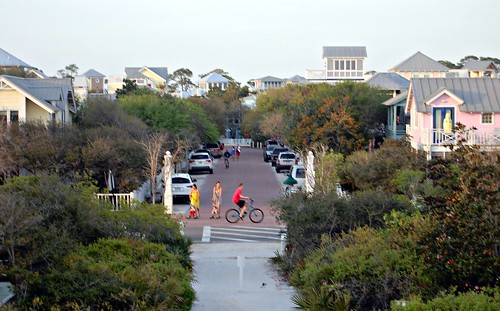Urbanism: Reconsidering Seaside, Florida
I'm hardly the only one whose career was strongly influenced by the now-iconic planned town of Seaside, on Florida's Panhandle coast. If I hadn't run across an article about Seaside, designed by new urbanist stalwarts Duany Plater-Zyberk – and, around the same time, visionary architect Peter Calthorpe's book about transit-oriented development – I'm not sure what I would be doing now. I had been concerned about suburban sprawl as an environmental catastrophe, but I didn't have a good answer.
Seaside, designed to be compact and walkable, like an old-fashioned prewar town, provided part of the answer and changed my career.
It's easy to mock Seaside, and plenty do, for being overplanned, a neo-traditional artifice too consumed with nostalgia for an idyllic past that never quite existed as reconceived. Being featured in the Jim Carrey movie The Truman Show certainly didn't help. Neither does its function as a resort community of second homes for an upscale clientele. Some of that is fair, in my opinion.
But the story is so much more good than bad. One has to remember, as the video below reminds us, that the compact, 80-acre town was conceived over 30 years ago, when almost no one was building walkable communities. If it wasn't sprawl, it didn't sell, or so people thought. Seaside may have been built on decades-old premises, but it was downright radical for its day.
Seaside was employing green infrastructure for stormwater management before we environmentalists knew there was such a thing – not because the developer or architects were environmentally conscious, but because they were adverse to debt. Things like pervious pavement and bioretention ponds simply cost less than building conventional "gray" stormwater infrastructure with underground pipes. Lawns were costly and difficult to maintain on the site, so the design emphasized use of native vegetation. Narrow streets, also built to save money, slowed vehicle traffic and supported safe streets for kids.
There were plenty of other innovations, too, and they are newly chronicled in two new works: First, Dhiru Thadani's beautifully written and illustrated new book, Visions of Seaside, tells the complete story of Seaside's conception and evolution. It's not a small volume at 600 pages, but Visions is as seriously impressive as its subject. Lovers of architecture and town planning will be fascinated, as much by the book's depiction of proposals for the town that, for one reason or another, did not get built as by the descriptions of what did.
Second, the engaging video about Seaside below, produced by Chris Elisara for the American Makeover series, provides as good a short, hands-on lesson about innovative city planning as you are likely to find anywhere. Highly recommended:

